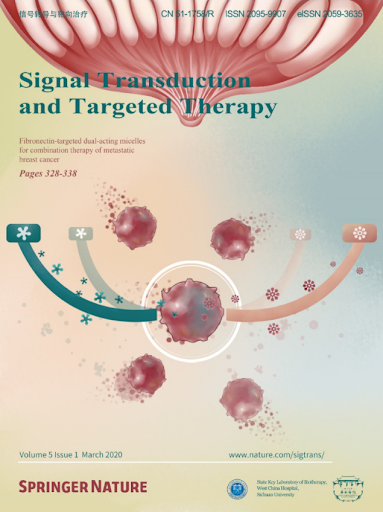An aptamer-drug conjugate for promising cancer therapy with comprehensive evaluation from rodents to non-human primates.
IF 52.7
1区 医学
Q1 BIOCHEMISTRY & MOLECULAR BIOLOGY
引用次数: 0
Abstract
Aptamers serve as unique targeting ligands, making aptamer-drug conjugates (ApDCs) an attractive strategy for targeted cancer therapy. This study performs a comprehensive evaluation from rodents to non-human primates (NHP) of a protein tyrosine kinase 7 (PTK7)-targeted ApDC (Sgc8c-M) made by conjugating the potent antimitotic agent monomethyl auristatin E (MMAE) to the classic PTK7 aptamer Sgc8c. Efficacy studies in various cancer types with PTK7 overexpression showed that Sgc8c-M effectively induces sustained tumor regression in cell line-derived and patient-derived xenografts, outperforming unconjugated MMAE, the chemotherapy drug paclitaxel, and a PTK7-targeted antibody-drug conjugate. Pharmacokinetic (PK) studies in mice revealed that Sgc8c-M leads to rapid accumulation and sustained MMAE levels in tumors, along with fast clearance from plasma and normal tissues. Further study in rats confirmed rapid clearance across most organs and revealed that over 75% of MMAE was excreted through urine and feces within 24 h. Toxicokinetic (TK) assessments indicated comparable systemic drug exposure without accumulation for repeated doses compared to single administration. Toxicity evaluations showed that the therapeutic dose with high efficacy was safe and that the toxicity resulting from extremely high doses could be reversibly controlled. Encouraged by these findings, we evaluated PK/TK profiles and safety of Sgc8c-M in cynomolgus monkeys. Similar to PK/TK profiles observed in rats, Sgc8c-M demonstrated good dose-dependent drug exposure. It was, moreover, well tolerated in monkeys with no obvious accumulation following multiple administrations. These findings highlight the potential of Sgc8c-M as an effective antitumor agent and provide useful insights for the clinical translation of emerging ApDCs.从啮齿类动物到非人类灵长类动物,一种有前景的癌症治疗的适体-药物偶联物。
适配体作为一种独特的靶向配体,使适配体-药物偶联物(ApDCs)成为靶向癌症治疗的一种有吸引力的策略。本研究从啮齿类动物到非人灵长类动物(NHP)对一种蛋白酪氨酸激酶7 (PTK7)靶向ApDC (Sgc8c- m)进行了综合评价,该ApDC是由强效抗核分裂剂monomethyl auristatin E (MMAE)与PTK7经典适配体Sgc8c偶联而成。对PTK7过表达的各种癌症类型的疗效研究表明,Sgc8c-M有效地诱导细胞系来源和患者来源的异种移植物的持续肿瘤消退,优于未偶联的MMAE、化疗药物紫杉醇和PTK7靶向抗体-药物偶联物。小鼠药代动力学(PK)研究表明,Sgc8c-M可导致肿瘤中MMAE的快速积累和持续水平,并可快速从血浆和正常组织中清除。在大鼠中的进一步研究证实了大多数器官的快速清除,并显示超过75%的MMAE在24小时内通过尿液和粪便排出。毒性动力学(TK)评估表明,与单次给药相比,重复给药的系统性药物暴露没有积累。毒性评价表明,高效的治疗剂量是安全的,极高剂量引起的毒性是可以可逆控制的。受这些发现的鼓舞,我们评估了Sgc8c-M在食蟹猴中的PK/TK谱和安全性。与在大鼠中观察到的PK/TK谱相似,Sgc8c-M表现出良好的剂量依赖性药物暴露。此外,在多次给药后,猴子的耐受性良好,没有明显的积累。这些发现突出了Sgc8c-M作为一种有效的抗肿瘤药物的潜力,并为新兴apdc的临床翻译提供了有用的见解。
本文章由计算机程序翻译,如有差异,请以英文原文为准。
求助全文
约1分钟内获得全文
求助全文
来源期刊

Signal Transduction and Targeted Therapy
Biochemistry, Genetics and Molecular Biology-Genetics
CiteScore
44.50
自引率
1.50%
发文量
384
审稿时长
5 weeks
期刊介绍:
Signal Transduction and Targeted Therapy is an open access journal that focuses on timely publication of cutting-edge discoveries and advancements in basic science and clinical research related to signal transduction and targeted therapy.
Scope: The journal covers research on major human diseases, including, but not limited to:
Cancer,Cardiovascular diseases,Autoimmune diseases,Nervous system diseases.
 求助内容:
求助内容: 应助结果提醒方式:
应助结果提醒方式:


